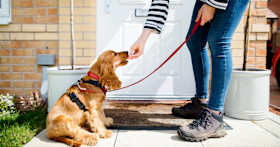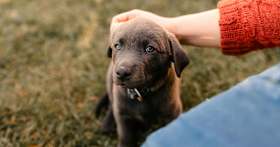Is It Normal for New Dogs to Sleep a Lot?
There’s tired. And then there’s tired-tired. Here’s how to tell if your dog is just sleepy, or if something is wrong.
There’s tired. And then there’s tired-tired. Here’s how to tell if your dog is just sleepy, or if something is wrong.
by Mia Nguyen, CPDT-KA, FFCP, | May 30, 2025

Michael Carni / Adobe Stock
So you just brought home a new dog, and you’ve noticed they’re sleeping a lot. Maybe they’re not as active as you expected, or they just seem quieter than average. It may surprise you that, on average, most dogs sleep between 12 and 14 hours a day (and upwards of 20 hours) depending on age. However, a dog can sleep more than average for a variety of reasons, including age, stress, weather, or a medical condition. So what’s truly normal, and when should you be concerned? This article will explore all of the questions you may have about dogs’ sleep.
Your dog could be sleeping so much for many reasons. Dogs will often sleep a lot as they adjust to a new environment or a schedule change. For dogs who are new to a home, sleep helps them reset, process new information, and decompress from all the recent changes.
You may also be adjusting to what is normal for your dog, in particular. Depending on age and normal activity level, what you see may be typical sleeping behavior for your dog. For dogs new to the home, it is best to give them time to adjust to the new environment, their new bed, family members, and schedule before determining if the dog’s sleep schedule is something that warrants a trip to the vet.
Generally, it is recommended to give a new dog three days to decompress, three weeks to settle in, and three months to build trust and bond with their new family. General findings in canine behavior research have shown that dogs experience elevated cortisol levels in shelters that can take several weeks to normalize post-adoption, reflecting the stress of transitioning environments, which directly impacts the sleep cycle. While the 3-3-3 rule is widely used in shelters, it can be applied to bringing home any new dog. Keep in mind that this isn’t a strict rule: Each dog is different, with unique needs.

Laura Stolfi / Stocksy
A restless dog who won’t sleep at night may be indicating that something needs to change. Whether the cause is behavioral, environmental, or medical, addressing each factor can help ensure a more peaceful night for both you and your dog.
Here are some common causes for nighttime restlessness and how to address them.
Pent-up energy can be the result of not enough daytime exercise or mental stimulation. This can be easily resolved by increasing daytime activities and mental enrichment through walks, training, puzzle toys, and so on.
Anxiety or stress can be another reason for restless nights and is common post-adoption, given the change in routine and new environment. This type of anxiety can be alleviated by creating a bedtime routine and a calm, comfortable sleeping space.
Needing to potty may be a factor in why your dog is distressed in the middle of the night. Be sure to take them out to relieve themselves as part of your bedtime routine and limit late-night snacks and water, if necessary.
Discomfort, pain, or a medical condition is a serious factor to consider, especially in senior dogs. Health issues such as arthritis, allergies, or cognitive dysfunction are common reasons dogs may be restless at night. These are best addressed with the help of a veterinarian.

SvetikovaV / Shutterstock
Yes, dogs’ sleep schedules and needs change as they age, much as they do in humans. Here’s an overview of the average hours of sleep dogs get at each life stage.
Puppies up to six months of age will typically sleep between 18 and 20 hours a day to support brain development, immune function, and physical growth. A puppy’s sleep schedule is usually spread throughout the day and night, with frequent naps in between.
As dogs reach adolescence, they begin consolidating sleep into longer overnight periods with the occasional nap throughout the day. This is typically when you will start to see more variations dependent on breed and activity levels.
Adult dogs will likely settle into predictable nighttime sleep patterns with a few daytime naps. Working or active dogs may sleep less, while homebodies and couch potatoes may sleep more.
Senior dogs often sleep more due to decreased energy levels, health conditions (such as arthritis), or cognitive changes. Sleep at this life stage may become lighter and more fragmented, with more daytime napping and irregular nighttime sleep
Sleep is also influenced by factors such as a dog’s breed, activity level, and overall health. Larger breeds typically sleep more than smaller ones. Dogs with limited stimulation may nap out of boredom. And medical issues can increase or disrupt sleep patterns.
Sleep needs will depend on a dog’s age, breed, size, activity level, and health. On average, dogs need 12 to 20 hours of sleep, which varies greatly by each dog’s lifestyle and current life stage.
It can be OK if your dog sleeps most of the day, depending on their age, breed, activity level, and overall health. But there are times when your dog’s sleeping behaviors are signaling a problem. If your dog is sleeping for long periods after exercise, training, or excitement, that is completely normal. As long as your dog is relaxed, eating normally, and responsive when awake, your dog is probably resting normally.
On the other hand, if your dog is lethargic while awake, has a loss of appetite, is experiencing behavior changes, or has any other medical symptoms (such as limping or vomiting), you should see your veterinarian. If you are concerned about subtle changes, you can track your dog’s sleep and note any changes in appetite, mobility, or mood. A quick check-up with your vet to rule out medical concerns is always a safe bet.
A dog who isn’t getting enough sleep will likely show signs of overtiredness similar to a child. They might be irritable, unfocused, and more reactive. You may see that an overtired dog is:
Unable to settle
More sensitive to stimuli
Restless or pacing
Getting sick more often
Having a harder time focusing
More anxious, nervous, or reactive
For young dogs and puppies, you may see an increase in mouthiness. Chronic sleep deprivation is more likely to look like overstimulation rather than exhaustion, especially in young, high-drive dogs.
You should take your dog to the vet if their sleep or behavior changes suddenly or drastically, especially if paired with other symptoms. Vomiting, diarrhea, appetite changes, limping, excessive thirst, or urination, combined with sudden behavioral or sleep changes, are cause for concern. In general, if your dog is not behaving like their normal self for more than 24 to 48 hours, it is time to visit the vet.
Yes, you can start by looking at your own sleep routine and structure your dog’s routine around that. As long as you keep things consistent, establishing a sleep schedule should be a breeze.
To help your dog get quality sleep, be sure to meet their physical and emotional needs before bedtime. Create a calm, comfortable environment to promote healthy sleep habits in addition to establishing a routine.
Generally, you should not wake up a sleeping dog. If your dog is sleeping too much, it is likely because their body needs it. Rather, consider a vet visit to rule out any medical conditions.
Faulkner, Brian. “How Much Should My Dog Be Sleeping?” Petplan, May 11, 2021. www.petplan.co.uk/pet-information/dog/advice/how-much-should-my-dog-be-sleeping.
Gácsi, Márta, József Topál, Ádám Miklósi, Antal Dóka, and Vilmos Csányi. “Attachment Behavior of Adult Dogs (Canis Familiaris) Living at Rescue Centers: Forming New Bonds.” Journal of Comparative Psychology 115, no. 4 (December 2001): 423–31. doi.org/10.1037/0735-7036.115.4.423.
Gibeault, Stephanie. “How to Tell When Your Dog Is in Pain & How to Help.” American Kennel Club, February 26, 2024. www.akc.org/expert-advice/health/signs-dog-is-in-pain.
Kinsman, Rachel, Sara Owczarczak-Garstecka, Rachel Casey, Toby Knowles, Séverine Tasker, Joshua Woodward, Rosa Da Costa, and Jane Murray. “Sleep Duration and Behaviours: A Descriptive Analysis of a Cohort of Dogs up to 12 Months of Age.” Animals 10, no. 7 (July 10, 2020): 1172. doi.org/10.3390/ani10071172.
Laan, Janneke Elisabeth van der, Claudia Maureen Vinke, and Saskia Stefanie Arndt. “Evaluation of Hair Cortisol as an Indicator of Long-Term Stress Responses in Dogs in an Animal Shelter and after Subsequent Adoption.” Scientific Reports 12, no. 1 (April 21, 2022). doi.org/10.1038/s41598-022-09140-w.
Mondino, Alejandra, Magaly Catanzariti, Diego Martin Mateos, Michael Khan, Claire Ludwig, Anna Kis, Margaret E. Gruen, and Natasha J. Olby. “Sleep and Cognition in Aging Dogs. A Polysomnographic Study.” Frontiers in Veterinary Science 10 (April 28, 2023). doi.org/10.3389/fvets.2023.1151266.
Takeuchi, Takashi, and Etsumori Harada. “Age-Related Changes in Sleep-Wake Rhythm in Dog.” Behavioural Brain Research 136, no. 1 (October 2002): 193–99. doi.org/10.1016/s0166-4328(02)00123-7.
Woods, Hope J., Ming Fei Li, Ujas A. Patel, B. Duncan Lascelles, David R. Samson, and Margaret E. Gruen. “A Functional Linear Modeling Approach to Sleep–Wake Cycles in Dogs.” Scientific Reports 10, no. 1 (December 17, 2020). doi.org/10.1038/s41598-020-79274-2.

Mia is a Certified Professional Dog Trainer and Behavior Consultant with a deep passion for helping dogs and their families build positive, lasting relationships. As the owner and trainer of Ace’s Pace based out of Sacramento, CA, she focuses on fear-free, science-backed techniques to guide pet parents through the nuances of dog behavior, training, and enrichment. Through a gentle, positive approach rooted in understanding and trust, Mia strives to help every dog live their best life, with the support and guidance that pet parents need to be successful. You can follow Mia and her life with dogs on Instagram at aces.pace.sacramento.

Adoption Advice

Breed Info

Adoption Advice

Behavior & Training
Before you enthusiastically cry out “yes,” it’s important to first consider your lifestyle and training goals.

Behavior & Training
Make your pup a potty pro with these house training tips.

Foster & Volunteer
They’re cute, but puppies are also a lot of work. Before you foster, just make sure you’re prepared, so it’s the heart-warming experience you’re hoping it’ll be.

Behavior & Training
Discover when nighttime crating makes sense, when it doesn’t, and how to make it a positive experience.

Adoption Advice

Behavior & Training

Behavior & Training
Dogs need space to live their best lives, but how much is enough?

Adoption Advice
These studies prove that dogs’ awesomeness is more than just a vibe.

Behavior & Training
Feeling overwhelmed by your very, very energetic dog? This comprehensive guide explores practical solutions to help calm your lively companion.